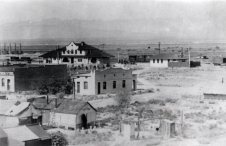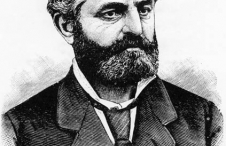Armenians in Southern Nevada
When Las Vegas started as a small railroad town in 1905, Armenian farmers, craftsmen, and merchants showed little interest in settling in a place best known for its arid desert, sparse natural resources, and limited trade connections. But over time, Armenians escaping persecution and genocide in their ancestral homeland in the eastern Mediterranean began to settle in Los Angeles, Fresno, and Las Vegas. Though Southern Nevada seemed at first to be an unlikely spot to forge a “new Armenia,” it is now home to 20,000 Armenians.
The promise of cheap land and business opportunities drew the first Armenian families to the Las Vegas Valley about 1911. Most Armenian immigrants to the United States during the early twentieth century had fled the pogroms perpetrated by the Ottoman Turks in 1895 that ravaged many Armenian settlements in eastern Turkey and caused the deaths of more than 100,000 people. A second wave of immigration, generated by even more dire circumstances, followed the lifting of World War I immigration restrictions. In 1915, systematic genocide of the Armenian people living under Ottoman rule began under the orders of the sultan, killing an estimated 1.5 million people out of a population of 2 million. By 1924, almost 100,000 Armenians had settled in the United States. That same year, Armenians were among the 521 students enrolled in classes in Reno at Nevada's then-only university.
Armenian immigration to the United States in more recent years has resulted from instability in the Middle East. Immigration from this region was made possible after the 1924 quota restrictions were eased in 1965. Armenian immigrants came to the United States in increasing numbers in 1975 in the wake of the civil war in Lebanon and again in 1978 during the Islamic Revolution in Iran. Some have estimated that as many as 160,000 Armenians immigrated to the United States during this period. Today, approximately 800,000 Armenians live in the United States. A large number of these immigrants, both new and old, are concentrated in the West. So many Armenians reside in Los Angeles, California, for example, that it has often been called the second-largest “Armenian” city in the world, trailing the capital of modern-day Armenia, Yerevan.
In Las Vegas, Armenian churches, cultural groups, political organizations, and businesses serve a diverse and vibrant community. Though Armenian cultural institutions in Las Vegas are relatively young compared with their counterparts in places like Los Angeles and Fresno, they have grown and thrived in recent years. Humanitarian relief work has played a central role in bringing Armenians together wherever they settle. Their own troubled history of war, genocide, and displacement has led to the development of institutions that aid Armenians in both the United States and Armenia. In Las Vegas, three Christian churches serve the Armenian community, two apostolic and one Protestant. Church auxiliary organizations raise funds for relief efforts and to support the philanthropic activities of their respective congregations. Outside of the church, the Armenian Relief Society women's aid organization performs charitable work in the community. The number of Armenian students attending the University of Nevada, Las Vegas has grown alongside the rise of the larger Armenian community, resulting in the founding of the Armenian Students Association. Businesses that cater to the Armenian community in Las Vegas include bakeries, pastry shops, and grocery stores.
Armenians in Las Vegas comprise a transnational community of immigrants. New residents have come from all over the United States, the Middle East, and the Republic of Armenia. Despite such diversity, Armenians in Las Vegas share a common heritage. No issue brings Armenians together more than the memory of the Armenian Genocide. As in other Armenian communities throughout the United States, April 24 is a day of remembrance for those Armenians who died at the hands of the Ottoman Turks in 1915. Candlelight vigils, educational events, and political activities make up the host of events that mark this important day for the community.
Las Vegas has seen the rise of a number of Armenians who have built and promoted the community here and abroad. Those who have achieved national prominence include financier Kirk Kerkorian, winning UNLV basketball coach Jerry Tarkanian, and champion tennis player and philanthropist Andre Agassi, whose father is of Armenian descent.





